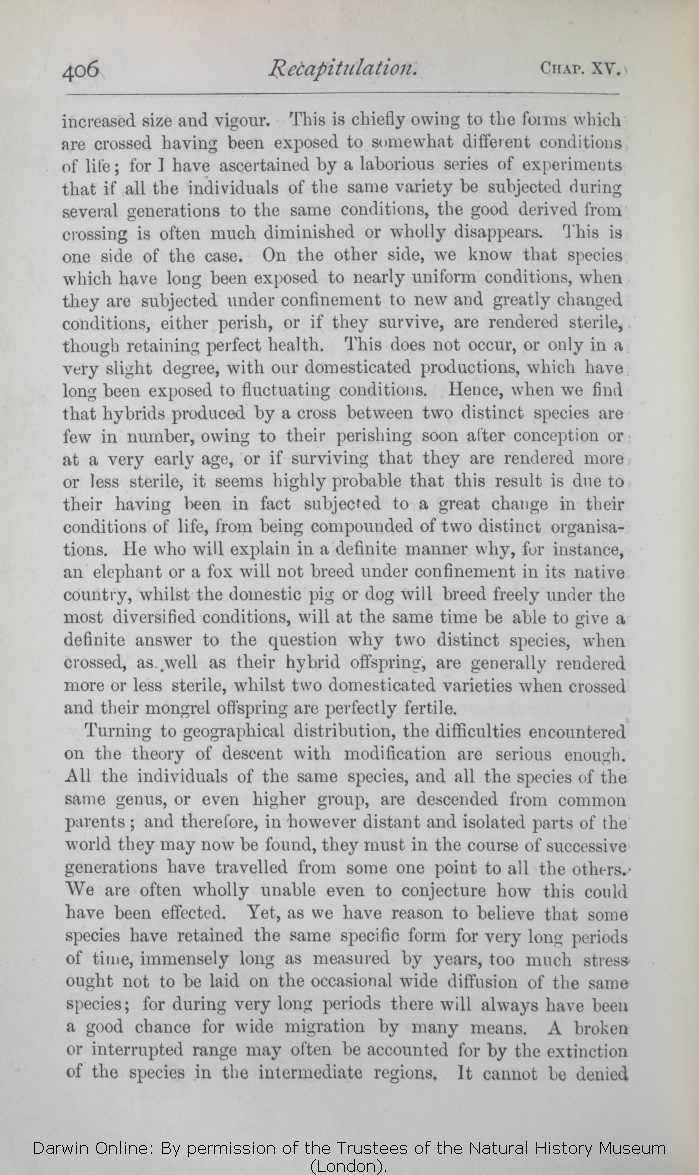increased size and vigour. This is chiefly owing to the forms which are crossed having been exposed to somewhat different conditions of life; for I have ascertained by a laborious series of experiments that if all the individuals of the same variety be subjected during several generations to the same conditions, the good derived from crossing is often much diminished or wholly disappears. This is one side of the case. On the other side, we know that species which have long been exposed to nearly uniform conditions, when they are subjected under confinement to new and greatly changed conditions, either perish, or if they survive, are rendered sterile, though retaining perfect health. This does not occur, or only in a very slight degree, with our domesticated productions, which have long been exposed to fluctuating conditions. Hence, when we find that hybrids produced by a cross between two distinct species are few in number, owing to their perishing soon after conception or at a very early age, or if surviving that they are rendered more or less sterile, it seems highly probable that this result is due to their having been in fact subjected to a great change in their conditions of life, from being compounded of two distinct organisations. He who will explain in a definite manner why, for instance, an elephant or a fox will not breed under confinement in its native country, whilst the domestic pig or dog will breed freely under the most diversified conditions, will at the same time be able to give a definite answer to the question why two distinct species, when crossed, as well as their hybrid offspring, are generally rendered more or less sterile, whilst two domesticated varieties when crossed and their mongrel offspring are perfectly fertile. ↑| 4 blocks not present in 1872; present in 1859 1860 1861 1866 1869 | | The sterility of hybrids is a very
different case from that of first
crosses,
for their
reproductive organs are
more or less functionally impotent; whereas in first crosses
the organs on
both sides
are in
a perfect condition.
As we continually see that organisms of all kinds are rendered in some degree sterile from their constitutions having been disturbed by slightly different and new conditions of life,
we need not feel surprise at hybrids being in some degree sterile, for their constitutions can hardly fail to have been
disturbed from being compounded of two distinct organisations.
This
parallelism is supported by another parallel, but directly opposite, class of facts;
namely, that the vigour and fertility of all organic beings are increased by slight changes in their conditions of life, and that the offspring of slightly modified forms or varieties acquire from being crossed
increased vigour and fertility.
So that, on the one hand, considerable
changes
in the conditions of life and crosses between greatly modified forms, lessen fertility; and on the other hand, lesser changes in the conditions of life and crosses between less modified forms, increase fertility.
|
|
Turning to geographical distribution, the difficulties encountered on the theory of descent with modification are
serious | serious 1861 1866 1869 1872 | | grave 1859 1860 |
| are 1872 | | must have 1859 1860 1861 1866 1869 |
| may 1866 1869 1872 | | are 1859 1860 1861 |
| be found, 1866 1869 1872 | | found, 1859 1860 1861 |
| travelled 1869 1872 | | passed 1859 1860 1861 1866 |
| point 1866 1869 1872 | | part 1859 1860 1861 |
| all the 1866 1869 1872 | | the 1859 1860 1861 |
| form 1859 1860 1861 1869 1872 | | from 1866 |
| periods 1866 1869 1872 | | periods, 1859 1860 1861 |
| of time, immensely 1869 1872 |
| enormously 1859 1860 1861 |
| of time, enormously 1866 |
| ..... 1866 1869 1872 | | of time 1859 1860 1861 |
| have been 1860 1861 1866 1872 | | be 1859 1869 |
|









